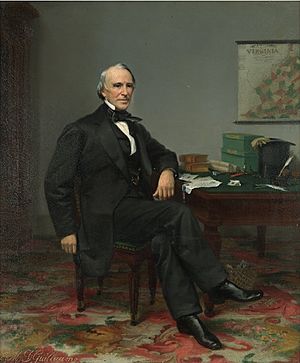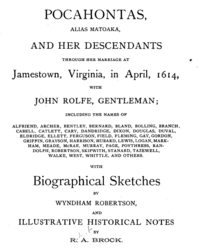Wyndham Robertson facts for kids
Quick facts for kids
Wyndham Robertson
|
|
|---|---|

Portrait of Wyndham Robertson ca. 1880 by L.M.D. Guillaume
|
|
| Acting Governor of Virginia | |
| In office 1836–1837 |
|
| Preceded by | Littleton Waller Tazewell as Governor |
| Succeeded by | David Campbell as Governor |
| Virginia House of Delegates | |
| In office 1838–1841 |
|
| Preceded by | Robert Stanard |
| Succeeded by | Raleigh T. Daniel |
| Constituency | Richmond, Virginia |
| Virginia House of Delegates | |
| In office 1859–1865 Serving with Gustavus A. Myers, David J. Saunders (1859-1860)
John O. Stegar, Thomas H. Wynne, Thomas B. Bigger (1861-1863) David I. Burr, David J. Saunders (1863-1865) |
|
| Preceded by | Joseph R. Anderson |
| Succeeded by | Peachy R. Grattan |
| Constituency | Richmond, Virginia |
| Personal details | |
| Born | January 26, 1803 near Manchester, Chesterfield County, Virginia |
| Died | February 11, 1888 (aged 85) Abingdon, Virginia |
| Nationality | American |
| Political party | Whig |
| Spouse | Mary Trigg Smith |
| Children | 4 daughters, 2 sons |
| Residence | Richmond, Virginia Abingdon, Virginia |
| Occupation | lawyer, farmer, businessman |
| Signature | |
Wyndham Robertson (January 26, 1803 – February 11, 1888) was an important political figure in Virginia. He served as the Acting Governor of Virginia from 1836 to 1837. He also spent several terms in the Virginia House of Delegates, which is like Virginia's state legislature. During the American Civil War, he represented Richmond in this role.
Robertson was a member of the Whig Party. He strongly believed that the United States should stay united, especially when states started talking about leaving the Union before the Civil War. However, once President Abraham Lincoln asked for troops, Robertson chose to support his home state of Virginia. After the war, he helped Virginia rejoin the United States peacefully. He also wrote a book about Pocahontas and her family, as he was one of her descendants.
Contents
Early Life and Family Connections
Wyndham Robertson was born in 1803 near Manchester, a town in Chesterfield County, Virginia. This area is located across the James River from Richmond. His mother, Elizabeth Bolling, was a descendant of the famous Native American woman Pocahontas and John Rolfe.
His father, William Robertson, was a member of Virginia's Council of State, a group that advised the governor. Wyndham had older brothers who also became important. Thomas B. Robertson became the Governor of Louisiana, and John Robertson became a U.S. Congressman. Wyndham went to private schools in Richmond and later graduated from The College of William & Mary in 1821. He then studied law.
In 1831, Wyndham Robertson married Mary Trigg Smith. Her father, Captain Francis Smith, had served in the Continental Army during the American Revolution. Wyndham and Mary had four daughters and two sons.
Political Career and Public Service
Robertson became a lawyer in Virginia in 1824. A few years later, he traveled to Paris and London. In 1830, he was elected to Virginia's Council of State, the same group his father had served on. He was re-elected to this council in 1833.
In 1834, Robertson suggested a new idea for transportation. Instead of building a canal all the way to the Kanawha River, he thought it would be better to build a railroad. He believed a railroad could eventually reach the Mississippi River.
Becoming Acting Governor
On March 31, 1836, Robertson became the most senior member of the Council of State. This meant he was like the Lieutenant-Governor of Virginia. On the very same day, Governor Littleton Waller Tazewell resigned. Because of this, Robertson automatically became the acting governor.
He served as acting governor until 1837. The Virginia General Assembly, which chose the governor, was mostly Democratic. Since Robertson was a Whig, he was not elected to continue as governor. David Campbell took his place.
Serving in the House of Delegates
After his time as governor, voters in Richmond elected Robertson to represent them in the Virginia House of Delegates. He served from 1838 to 1841. He was re-elected three times during this period.
In 1841, Robertson moved to his wife's family home near Abingdon, Virginia. He became a farmer there. He also became a Justice of the Peace for Washington County, Virginia and a trustee for Abingdon Academy. In 1849, he helped organize a meeting to extend the Virginia and Tennessee Railroad to Abingdon. He also leased the King Saltworks, which produced salt using enslaved labor.
Views on Slavery and the Civil War
Wyndham Robertson owned enslaved people throughout his life. Records show he owned 11 enslaved people in 1840, at least 28 in 1850, and 7 in Richmond and at least 75 in Washington County in 1860.
In 1858, Robertson moved back to Richmond. In 1859, he was again elected to the Virginia House of Delegates. As Virginia debated whether to leave the United States, Robertson was a strong supporter of keeping the country together. He called himself a "friend to peace and the Union."
At a special event in 1860, Robertson gave a speech about the importance of the Union. He said:
The Constitutional Union of the States" - The Union of the States is the harmony of the spheres. While obedient to the laws of their creation, they sing ever as they go 'glad tidings of great joy' to all the world. Rebelling against them, light and joy are swallowed up in darkness, and order falls back into primordial chaos.
Even after South Carolina and other states started to leave the Union in 1860-61, Robertson continued to argue against Virginia seceding. On January 7, 1861, he proposed the "Anti-Coercion Resolution." This resolution rejected secession but stated that if the U.S. government used force against the states that had left, Virginia would fight. This resolution was passed.
When President Abraham Lincoln asked for troops on April 15, 1861, Robertson felt that the condition in his resolution had been met. From that point on, he actively supported Virginia's defense. Virginia officially left the Union after a public vote the following month.
Robertson continued to serve in the House of Delegates until the end of the Confederacy in 1865. In 1863, he opposed a bill that would have set fixed prices for food, believing it would cause serious problems. When some citizens asked their representatives to support the bill or resign, Robertson refused. He briefly resigned but was asked to withdraw it after a poll showed most people did not support the bill. He then kept his seat.
After the War and Legacy
After the Civil War ended, Robertson moved back to Abingdon. During the period known as Congressional Reconstruction, he was part of the Committee of Nine. This group, led by Alexander H. H. Stuart, worked to help Virginia rejoin the United States.
A big issue was Virginia's new state constitution, which wanted to prevent former Confederates from voting. The committee successfully talked with President Ulysses S. Grant and others in the government. They arranged for this part of the constitution to be voted on separately. It was defeated, and the rest of the new constitution was approved, allowing Virginia to rejoin the Union.

After the war, some writers began to question the famous story of Captain John Smith being rescued by Pocahontas. Wyndham Robertson, who was a descendant of Pocahontas, wrote a book to defend her and her story. The book was called Pocahontas alias Matoaka and Her Descendants through Her Marriage with John Rolfe. He argued that because her descendants were notable, Pocahontas herself was also important. He traced her family line, which included many well-known Virginia families.
Wyndham Robertson passed away on February 11, 1888. He was buried near his parents in Cobbs Cemetery in Chesterfield County. His papers, including his time as governor, are kept at the Library of Virginia.
Images for kids
-
Title page, Pocahontas, alias Matoaka, and Her Descendants through Her Marriage at Jamestown, Virginia, in April, 1614, with John Rolfe, Gentleman, written by Robertson and published at Richmond, 1887



